Abstract
Objectives:
To evaluate the frequency of depression among Saudi patients, and to correlate between the presence of depression and type of diabetes.
Methods:
The research approach was descriptive with a convenient subject of 100 male and female patients (27 subjects with Type 1 diabetes, 29 subjects with Type 2 diabetes, and 44 subjects with gestational diabetes) from March to June 2014 at Al-Solimania Primary Health Care Center, Al-Olaya, Riyadh, Kingdom of Saudi Arabia. Patients were interviewed individually using an interview questionnaire sheet formulated by researchers to assess lifestyle items, and Beck depression inventory was used to screen for depression.
Results:
Thirty-seven percent of those suffering from Type 1 diabetes, and 37.9% of subjects with Type 2 diabetes were diagnosed with depression, while only 13.6% of subjects with gestational diabetes were diagnosed with depression. The results also showed that more than half of the study subjects do not comply with either glucose check, or diet regimen.
Conclusion:
This study revealed that there is an association between diabetes and depression although the correlation between depression and diabetes is not significant, while there is significant relation with changes in body image. Patients with diabetes should be screened for depression, provided referral to appropriate social services and psychosocial support, and involvement of mental health professions when needed.
Depression is commonly found as a co-morbid condition in chronic medical illnesses in general, and diabetes mellitus (DM) in particular. Depression in patients with DM represents a complex, co-morbid condition, which is the result of complicated interactions between bio-psycho-social and genetic factors.(repeated text) Depression originates as a direct consequence of neurochemical changes with DM, which harmfully affects health outcomes. The combination of diabetes and depression is associated with decrease in functional abilities and self-care.1-4 Rustad et al5 conducted a meta-analysis of 42 published studies that included 21,351 adults, and found that the prevalence of major depression in people with diabetes was 11%, and the prevalence of clinically relevant depression was 31%. Diabetes mellitus is a common health problem with extreme medical and economic consequences. In developing countries from 2010 to 2030, there will be a 69% increase in the number of adults with diabetes, while in developed countries there will be a 20% increase.6 Moreover, the Arab world (North Africa, Middle East, and Gulf area) will have the second highest increase in percentage of people with diabetes in 2030 compared with the other parts of the world.6 While the prevalence of depression among Palestinian diabetic patients is higher than reported in other communities, Sweileh et al7 stated that 40% of screened patients were potential cases of depression. Depression plays an important role in non-compliance to medical treatment. Maintaining a dietary regimen and exercise often decrease in depressed patients, irregular lifestyles, and loss of interest in health.8 In diabetic patients, depression has been shown to have adverse effects on social, physical functioning, and quality of life (QoL) that are independent of the effects of the medical illness.9 Regarding association between depression and types of diabetes, Raval et al10 concluded an approximately 2-5% increase in the prevalence rates of depression in people with diabetes in South Asian settings compared with people without diabetes. A research by Egede et al11 established that depressive symptoms and major depressive disorders constitute a common co-morbid problem among Dutch outpatients with Type 1 and Type 2 diabetes. Roy et al12 added that the prevalence of depression is common in outpatients with Type 2 diabetes in Bangladesh. Coincidence of depression in people with diabetes is accompanied with non-compliance with medication, poor metabolic control, higher complication rates, decreased QoL, increased healthcare use and cost, increased disability, and lost productivity, all lead to increased risk of death.11 Evidence suggests a bi-directional relationship between depression and chronic medical illnesses, the health risk behaviors, and psychobiological changes associated with depression increase the risk for chronic medical illnesses, and biological changes. Also difficulties associated with chronic medical illnesses may cause depressive episodes. Furthermore, co-morbid depression is associated with increased medical symptom burden, functional impairment, medical expenses, incompliance to self-care regimens, on the other hand, depression may deteriorate the course of medical illnesses due to its effect on pro-inflammatory factors, hypothalamic-pituitary axis, autonomic nervous system, and metabolic factors. Katon13 additionally suggests that co-morbid depression in patients with diabetes is correlated to poor glycemic control, raised the vulnerability of cardiovascular diseases, higher functional disability, and all leads to mortality.14 The World Health Organization has estimated that in 2014 the global prevalence of diabetes is 9% of adults (18 years and older) had DM. In 2012, DM was the direct cause of 1.5 million deaths.15 According to a recent study by Rajab,16 there are nearly 5.5 million diabetics in Iran, and also 200,000 patients with diabetes are added annually. According to the International Diabetic Federation there were 3.8 million cases of diabetes in the Kingdom of Saudi Arabia (KSA) in 2014.17 In this study, we considered the co-presence of diabetes and depression, regardless whether diabetes, or depression is the primary disorder. The purpose of this study is to evaluate the frequency of depression among Saudi patients at Al-Solimania Primary Health Care Center (PHCC), and correlation between the presence of depression and types of diabetes.
Methods
A descriptive survey design was followed in this study. This study was conducted from March to June 2014 at Al-Solimania PHCC, Al-Olaya, Riyadh, Kingdom of Saudi Arabia (KSA). A convenient subject of 100 male and female Saudi diabetic patients was interviewed (27 Type 1, 29 Type 2, and 44 gestational diabetes [GD]). Included in the study were: Saudi patients from 20-65 years old, and diagnosed with Type 1, or Type 2, or GD. Patients having diabetic complications, and having psychiatric disorders were excluded in this study. Data were collected from patients using a questionnaire sheet. The questionnaire consisted of 2 main parts: part one - the socio-demographic and medical data, such as age, gender, education, duration of illness, glucose level, and type of treatment; and part 2 - Beck Depression Inventory (BDI),18 a 21-item screening questionnaire comprising 13 cognitive, and 8 somatic questions used to screen for depression. To ensure applicability to the Saudi language and culture, and in accordance to the Saudi health system and cultural context, the Arabic version underwent further review by an expert committee from KSA, consisting of 5 experts (PhD level and master-level health professionals) with expertise in primary care and survey research. The committee reviewed the translated instrument for suitability of wordings and meaning of the text to the Saudi context. The validity and reliability of the questionnaire were tested through a pilot study. The reliability and validity of the Beck scale in psychiatric and epidemiologic studies have been extensively demonstrated. There is also evidence for the sensitivity and utility of this diagnostic tool in diabetes, wherein symptoms of medical disease, such as fatigue, sleep disturbances, and sexual dysfunction, emulate criterion symptoms of psychiatric disorder. It is accepted as the best measure, and is used to guide clinical management.19,20 The cut-off points for severity scores were: 0-13 minimal; 14-19 mild; 20-28 moderate; and 29-63 severe.
Ethical considerations
An official permission to carry out the study was secured by sending official letters to the Directors of Al-Solimania PHCC in order to obtain permission for data collection. Each participant was interviewed individually by the researchers, and after explaining the aim of the study his/her oral consent to participate in the study was obtained. Conduction of interviews was carried out individually and establishing communication and a trusting relationship was important. The major ethical issue encountered was maintaining the confidentiality of the patients and health centers. The researchers ensured this by omitting patient identities from the questionnaires, and aggregating the results at the district level. Each interview lasted for approximately 30-45 minutes according to participant’s response. The tools were filled by the researcher during health assessment.
The collected data were organized, tabulated, and statistically analyzed using the Statistical Package for Social Sciences version 19 (IBM Corp, Armonk, NY, USA) for categorical data, the number and percent distribution was calculated, and differences in observations in relation to type of diabetes were tested using Monte Carlo exact test. For Beck score, the mean and standard deviations (mean ± SD) were calculated, and differences between studied groups were tested using analysis of variance (F), least significant test was used when the F test was found significant to determine differences between each 2 groups. A p<0.05 was considered significant.
Results
The study subject consists of 100 diabetic patients, and the age range was 45-49 years old (40.7 Type 1, 58.6 Type 2, and 52.5 GD) (Table 1). More than 76% were female, and more than half of the GD group has duration of illness from one to 4 years, while one third from Type 1 has the disease 12 years and more. The correlation between the level of depression and type of diabetes is presented in Table 2. More than 37% from Type 1, and 37.9% from Type 2 patient’s have significant depression. It points to no statistically significant difference correlation between the types of diabetes and level of depression (p=0.040). Concerning the relation between diabetic patient’s perceptions of changes in body image, Table 3 indicates that more than half of diabetic Type 1 patients were anxious regarding changes in body image, while 2.3% from GD felt that their appearance has negatively changed. Concerns regarding health and types of diabetes are presented in Table 4, where 48% of the studied subjects expressed more concern regarding health and pain, while 18.5% Type 1, 3.4% Type 2, and 25% GD group expressed no concern with their health. Compliance with the treatment regimen of diabetic patients and level of depression are explained in Table 5. More than half from Type 1 (51.9%), and Type 2 (51.7%) often comply with treatment regimen, while 25% from the GD group never complied. Concerning late insomnia as a symptoms of depression and types of diabetes, Table 6 shows that approximately one-third from Type 2 (34.5%) either wake up early in the morning and cannot fall back to sleep, or have no difficulty to fall back to sleep. While more than half from diabetes Type 1 (59.3%) wake up early in the morning and can fall back to sleep. More than two-thirds (43.2%) from the gestational diabetes group wake up early in the morning and cannot fall back to sleep.
Table 1.
Distribution of types of depression among patients with diabetes according to their socio-demographic and clinical characteristics.
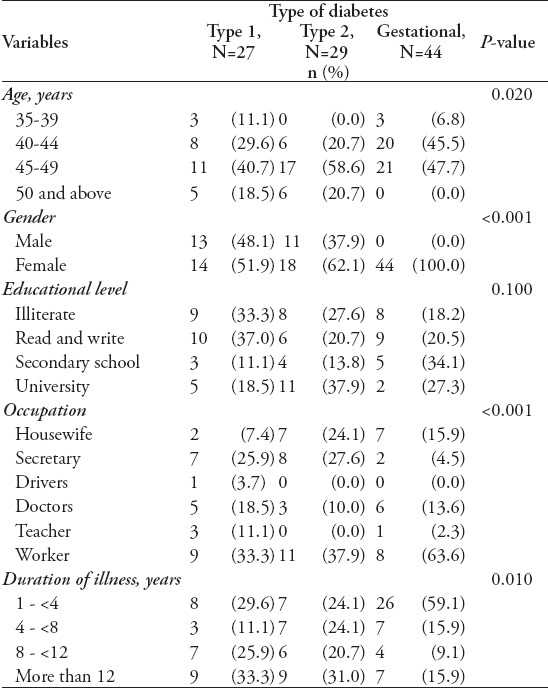
Table 2.
Correlation between levels of depression and type of diabetes of subjects included in this study.*
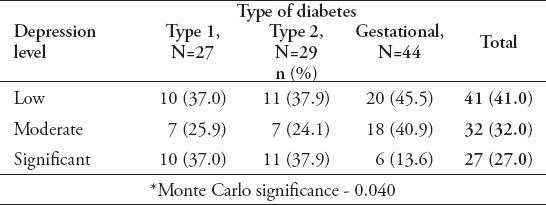
Table 3.
Diabetic patient’s perception of changes in body image according to results in this study.*
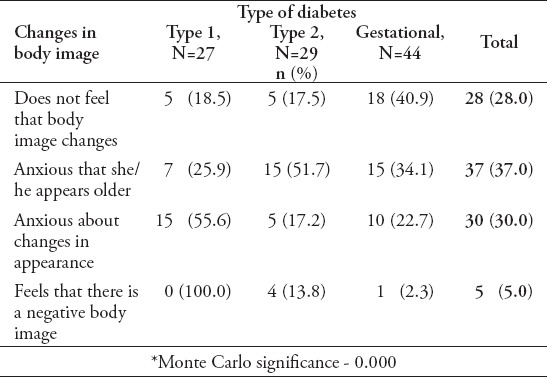
Table 4.
Correlation between concerns regarding health and types of diabetes of studied patient’s.*
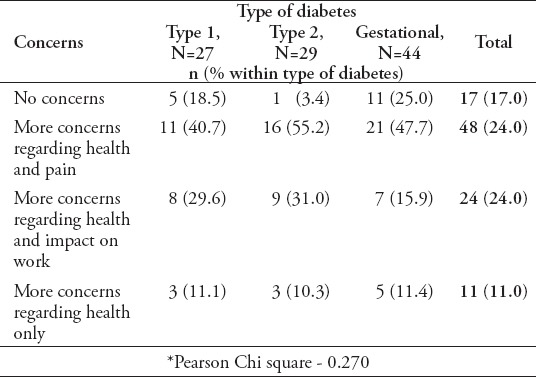
Table 5.
Compliance of diabetic studied patient’s with treatment regimen and level of depression.*
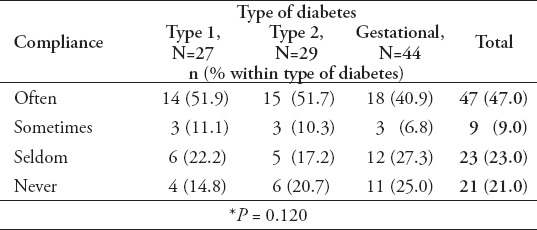
Table 6.
Late insomnia and types of diabetes of patient’s included in this study.*
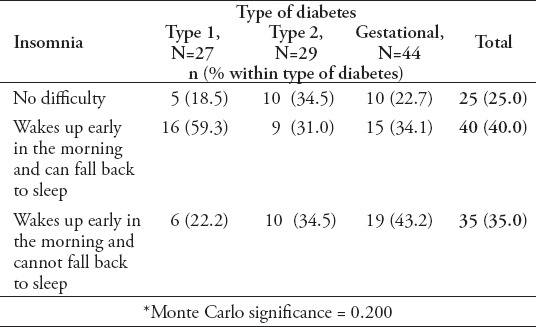
Discussion
Diabetes mellitus is a complex, long-term disease that affects day-to-day life, and can add further burden to an already complicated life.21 The more complications the person experiences, the greater the possibility that he/she may develop depressive symptoms.22 Depression is not generally listed as complications of diabetes, however, it can be one of the most common and dangerous complications. A study23 stated “one plus one equal more than 2 when we add depression and diabetes”.
The depressed patient with diabetes cannot achieve self-management behavior, which then make glycemic control more difficult, the reason that lead to serious complications.22 In this regard, the current study was conducted to assess the prevalence of depression among diabetic Saudi patients, and to correlate between the prevalence of depression among different types of diabetes (Type 1, Type 2, and GD). The study illustrates that a significant level of depression was observed among Type 1 and Type 2, also more than one quarter of the GD patients experienced the same level of depression, this finding is in accordance with Mansour et al,23 who found a strong association between diabetes and depression. Moreover, de Groot et al24 believed that diabetic patients are more likely to experience depression than their peers without diabetes.
Regarding perception of body image, this study revealed that more than half of Type 1 diabetic patients were anxious in changes in their body image, this may be due to the young age of Type 1 diabetic patients, and this comes in line with Taha et al,25 who found a strong relation between age and body image. Moreover, Kaminsky and Dewey26 stated that there is no significant differences in eating disorder symptoms and body image between adolescents with Type 1 diabetes and healthy comparison adolescents. On the other hand, only 2.3% of GD patients felt that their appearance is unpleasant, this is may be due to consequent body changes associated with pregnancy, labor and breast feeding, also a considerable percentage of female usually seeks the ideal standard of beauty, which makes them unhappy with their bodies. In relation to compliance with treatment regimen among all types of diabetes, the current study revealed that more than half of Type 1, and Type 2 diabetic patients comply with their treatment regimen, which is contradicted by Egede et al,27 who documented a decreased adherence to diet, exercise, and medication associated with depression among adults with diabetes. Meanwhile, approximately one-quarter of the gestational diabetics never comply, and three-fourths from Type 1 DM changed from often to seldom compliance. It may be explained by the nature of females, and variations of mood by the action of hormonal changes, which affects compliance and adherence.
Regarding health concerns among the studied subject, the current study revealed that nearly half of the subject expressed more concern on health. In this respect, Hendriks and Rademarkers28 stated that chronically ill patients are more and more expected to be in charge of their own health and health care they received. Meanwhile, Begum et al29 found that not all chronically ill are equally well-equipped and concerned of their health, and are willing to perform a variety of activities required for proper self-management. Meanwhile, approximately one quarter of GD patients express no concern regarding health, this may be justified by the thought that GD is a temporary disease, and may be treated and ended sooner or later, which predict patients lacking knowledge regarding the nature of the disease. With regard to late insomnia, the current study showed that one-third of Type 2 diabetes either reported awaking up early, and cannot fall back to sleep, or have no difficulty sleeping, this can be explained by the findings regarding the level of depression in the 3 different types of diabetes, and there was more than one-third of Type 2 patients had low level of depression, which cannot significantly affect sleep pattern, on the other hand, the same percentage were found to have significant level of depression, which affects the sleep pattern of the other third. Meanwhile nearly two-thirds of Type 1 diabetic patients wake up early and can fall back to sleep, this also can be due to that - the findings of two-thirds of Type 1 diabetic patient were experiencing either, low or moderate level of depression, which slightly affects sleep pattern. Meanwhile, it was noted that nearly half of the GD patients awake early and cannot fall back to sleep, this is consistent with Toffel et al30 who stated that there are association between sleep and depressed mood.
Limitation of the study
A convenient number of available patients were used, as random sampling will limit the number of patients included in the study.
In conclusion, the findings of the current study revealed that there is an association between diabetes and depression, although the correlation between depression and diabetes is not significant, while there is significant relation with changes in body image. Patients with diabetes should be screened for depression, referred to appropriate social services and psychosocial support, and involvement of mental health professionals when needed.
Footnotes
Related Articles.
Mansour EA, Gemeay EM, Moussa IM. Counseling and depression among diabetic patients. Saudi Med J 2013; 34: 295-301.
Lewko J, Zarzycki W, Krajewska-Kułak E. Relationship between the occurrence of symptoms of anxiety and depression, quality of life, and level of acceptance of illness in patients with type 2 diabetes. Saudi Med J 2012; 33: 887-894.
Al-Hayek AA, Robert AA, Alzaid AA, Nusair HM, Zbaidi NS, Al-Eithan MH, et al. Association between diabetes self-care, medication adherence, anxiety, depression, and glycemic control in type 2 diabetes. Saudi Med J 2012; 33: 681-683.
References
- 1.Das R, Singh O, Thakurta RG, Khandakar MR, Ali SN, Mallick AK, et al. Prevalence of depression in patients with type II diabetes mellitus and its impact on quality of life. Indian J Psychol Med. 2013;35:284–289. doi: 10.4103/0253-7176.119502. [DOI] [PMC free article] [PubMed] [Google Scholar]
- 2.Riba M. Depression and diabetes. J Nerv Ment Dis. 2011;199:907. [Google Scholar]
- 3.Egede LE, Ellis C. Diabetes and depression: global perspectives. Diabetes Res Clin Pract. 2010;87:302–312. doi: 10.1016/j.diabres.2010.01.024. [DOI] [PubMed] [Google Scholar]
- 4.Breznoščáková D, Nagyova I Depression and Glucose Metabolism (Diabetes Mellitus). Mental and Behavioural Disorders and Diseases of the Nervous System. Mood Disorders. In: Kocabasoglu N, editor. Rijeka (Croatia): InTechOpen; 2013. [Google Scholar]
- 5.Rustad JK, Musselman DL, Nemeroff CB. The relationship of depression and diabetes: pathophysiological and treatment implications. Psychoneuroendocrinology. 2011;36:1276–1286. doi: 10.1016/j.psyneuen.2011.03.005. [DOI] [PubMed] [Google Scholar]
- 6.Shaw JE, Sicree RA, Zimmet PZ. Global estimates of the prevalence of diabetes for 2010 and 2030. Diabetes Res Clin Pract. 2010;87:4–14. doi: 10.1016/j.diabres.2009.10.007. [DOI] [PubMed] [Google Scholar]
- 7.Sweileh WM, Abu-Hadeed HM, Al-Jabi SW, Zyoud SH. Prevalence of depression among people with type 2 diabetes mellitus: a cross sectional study in Palestine. BMC Public Health. 2014;14:163. doi: 10.1186/1471-2458-14-163. [DOI] [PMC free article] [PubMed] [Google Scholar]
- 8.Rahman M, Rahman MA, Flora MS, Rakibuz-Zaman M. Depression and associated factors in diabetic patients attending an urban hospital of Bangladesh. International Journal of Collaborative Research on Internal Medicine & Public Health. 2011;3:65–76. [Google Scholar]
- 9.Agbir TM, Adebowale TO. Clinical Correlates of Depression among Diabetics in Jos, Nigeria. Journal of Medicine in the Tropics. 2010;12:37–41. [Google Scholar]
- 10.Raval A, Dhanaraj E, Bhansali A, Grover S, Tiwari P. Prevalence and determinants of depression in type 2 diabetes patients in a tertiary care centre. Indian J Med Res. 2010;132:195–200. [PubMed] [Google Scholar]
- 11.Egede LE, Ellis C. Diabetes and depression: global perspectives. Diabetes Res Clin Pract. 2010;87:302–312. doi: 10.1016/j.diabres.2010.01.024. [DOI] [PubMed] [Google Scholar]
- 12.Roy T, Lloyd CE, Parvin M, Mohiuddin KG, Rahman M. Prevalence of co-morbid depression in out-patients with type 2 diabetes mellitus in Bangladesh. BMC Psychiatry. 2012;12:123. doi: 10.1186/1471-244X-12-123. [DOI] [PMC free article] [PubMed] [Google Scholar]
- 13.Katon WJ. Epidemiology and treatment of depression in patients with chronic medical illness. Dialogues Clin Neurosci. 2011;13:7–23. doi: 10.31887/DCNS.2011.13.1/wkaton. [DOI] [PMC free article] [PubMed] [Google Scholar]
- 14.Rustad JK, Musselman DL, Nemeroff CB. The relationship of depression and diabetes: pathophysiological and treatment implications. Psychoneuroendocrinology. 2011;36:1276–1286. doi: 10.1016/j.psyneuen.2011.03.005. [DOI] [PubMed] [Google Scholar]
- 15.Global Status Report on Non-Communicable Diseases 2014. Geneva (CH): World Health Organization; 2012. [Updated 2015 January]. Available from: http://www.who.int/mediacentre/factsheets/fs312/en . [Google Scholar]
- 16.Rajab A. The year 200 thousand patients with diabetes grows in Iran 2011. Available from: http://diabetes.darmanyab.com/?p=1817 .
- 17.International Diabetic Federation Middle East and North Africa. Diabetes in Saudi Arabia - 2014. Available from: https://www.idf.org/membership/mena/saudi-arabia .
- 18.Beck AT, Ward CH, Mendelson M, Mock J, Erbaugh J. An inventory for measuring depression. Arch Gen Psychiatry. 1961;4:561–571. doi: 10.1001/archpsyc.1961.01710120031004. [DOI] [PubMed] [Google Scholar]
- 19.American Diabetes Association. Standards of medical care in diabetes--2009. Diabetes Care. 2009;32(Suppl 1):S13–S61. doi: 10.2337/dc09-S013. [DOI] [PMC free article] [PubMed] [Google Scholar]
- 20.Steer RA, Ball R, Ranieri WF, Beck AT. Dimensions of the Beck Depression Inventory-II in clinically depressed outpatients. J Clin Psychol. 1999;55:117–128. doi: 10.1002/(sici)1097-4679(199901)55:1<117::aid-jclp12>3.0.co;2-a. [DOI] [PubMed] [Google Scholar]
- 21.Leone T, Coast E, Narayanan S, de Graft Aikins A. Diabetes and depression comorbidity and socio-economic status in low and middle income countries (LMICs): a mapping of the evidence. Global Health. 2012;8:39. doi: 10.1186/1744-8603-8-39. [DOI] [PMC free article] [PubMed] [Google Scholar]
- 22.Naranjo DM, Fisher L, Areán PA, Hessler D, Mullan J. Patients with type 2 diabetes at risk for major depressive disorders overtime. Ann Fam Med. 2011;9:115–120. doi: 10.1370/afm.1212. [DOI] [PMC free article] [PubMed] [Google Scholar]
- 23.Mansour E, Gemeay E, Mussa I. Counselling and depression among diabetic patients. Saudi Med J. 2013;34:295–301. [PubMed] [Google Scholar]
- 24.de Groot M, Kushnick M, Doyle T, Merrill J, McGlynn M, Shubrook J, et al. Depression among adults with diabetes: prevalence, impact, and treatment options. Diabetes Spectr. 2010;23:15–18. doi: 10.2337/diaspect.23.1.15. [DOI] [PMC free article] [PubMed] [Google Scholar]
- 25.Taha N, Mansour E, Sobhy A, Youness E. Comparison between body image and self-esteem among female nursing students in three different Arab Countries. The Medical Journal of Cairo University. 2011;79:509–517. Available from: http://www.erepository.cu.edu.eg/index.php/MJCU/article/view/853/834 . [Google Scholar]
- 26.Kaminsky LA, Dewey D. Psychological correlates of eating disorder symptoms and body image in adolescents with type 1 diabetes. Can J Diabetes. 2013;37:408–414. doi: 10.1016/j.jcjd.2013.06.011. [DOI] [PubMed] [Google Scholar]
- 27.Egede L, Ellis C, Grubaugh A. The effect of depression on self care behaviors and quality of care in a national sample of adults with diabetes. Gen Hosp Psychiatry. 2009;31:422–427. doi: 10.1016/j.genhosppsych.2009.06.007. [DOI] [PubMed] [Google Scholar]
- 28.Hendrisk M, Rademakers J. Relationships between patient activation, disease-specific knowledge and health outcomes among people with diabetes;a survey study. BMC Health Serv Res. 2014;14:393. doi: 10.1186/1472-6963-14-393. [DOI] [PMC free article] [PubMed] [Google Scholar]
- 29.Begum N, Donald M, Ozolins IZ, Dower J. Hospital admissions, emergency department utilisation and patient activation for self-management among people with diabetes. Diabetes Res Clin Pract. 2011;93:260–267. doi: 10.1016/j.diabres.2011.05.031. [DOI] [PubMed] [Google Scholar]
- 30.Toffel E, Kalleinen N, Urrila AS, Himanen SL, Porkka-Heiskanen T, Partonen T, et al. The relationship between mood and sleep in different female reproductive states. BMC Psychiatry. 2014;14:177. doi: 10.1186/1471-244X-14-177. [DOI] [PMC free article] [PubMed] [Google Scholar]


